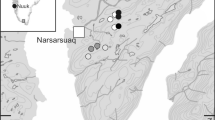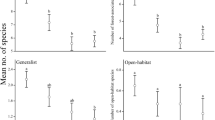Abstract
Coexistence is thought to be based mainly on interspecific differences in the use of limiting resources and habitat choice, both being associated with specific traits. We studied morphological parameters within an assemblage of large wandering spider species in Costa Rica subdivided into three subguilds: (1) semi-aquatic species, (2) forestground dwellers and (3) vegetation dwellers. We hypothesized that the observed differences between the spider species in microhabitat preferences and abilities to adhere to smooth surfaces should be associated with corresponding morphological traits. The leg scopulation patterns were surprisingly complex and reflected the ecological preferences of the spiders. We found that the scopulation patterns and the ratio of tarsus to leg length (T/L) appeared to be most important: the poor adhesion abilities of the semi-aquatic species were reflected by the absence of tarsal claw tufts, and these species also showed the highest T/L ratio. The forest-ground dwellers had smaller claw tufts relative to body mass than the vegetation dwellers that consistently showed the best adhesion performance. This study presents the first family-spanning ecomorphological analysis of an assemblage of large tropical wandering spiders.

















Similar content being viewed by others
References
Abramoff MD, Magalhaes PJ, Ram SJ (2004) Image processing with ImageJ. Biophoton Int 11(7):36–42
Barth FG (2001) Sinne und Verhalten: aus dem Leben einer Spinne. Springer, Berlin
Betz O (2002) Performance and adaptive value of tarsal morphology in rove beetles of the genus Stenus (Coleoptera, Staphylinidae). J Exp Biol 205:1097–1113
Beuttell K, Losos JB (1999) Ecological morphology of Caribbean anoles. Herpetol Monogr 13:1–28
Carico JE (1993) Revision of the genus Trechalea Thorell (Araneae, Trechaleidae) with a review of the taxonomy of the Trechaleidae and Pisauridae of the western hemisphere. J Arachnol 21:226–257
Elstrott J, Irschick DJ (2004) Evolutionary correlations among morphology, habitat use and clinging performance in Caribbean Anolis lizards. Biol J Linn Soc 83:389–398
Foelix RF (1992) Biologie der Spinnen. 2. Aufl. Thieme
Foelix RF, Jackson RR, Henksmeyer A, Hallas S (1984) Tarsal hairs specialized for prey capture in the Salticid Portia. Rev Arachnol 5:329–334
Gamble T, Greebaum E, Jackman TR, Russell AP, Bauer AM (2012) Repeated origin and loss of adhesive toepads in geckos. PLoS One 7:e39429
Gasnier TR, Azevedo CS, Torres-Sánchez MP, Höfer H (2002) Adult size of eight hunting spider species in central Amazonia: temporal variations and sexual dimorphisms. J Arachnol 30:146–154
Höfer H, Brescovit AD (2000) A revision of the Neotropical spider genus Ancylometes Bertkau (Araneae: Pisauridae). Insect Syst Evol 31:323–360
Jocqué R, Alderweireldt M (2005) Lycosidae: the grassland spiders. In: Deltshev C, Stoev P (eds) European arachnology. Acta Zool Bulgar, Suppl 1: 125–130
Kesel AB, Martin A, Seidl T (2003) Adhesion measurements on the attachment devices of the jumping spider Evarcha arcuata. J Exp Biol 206:2733–2738
Kesel AB, Martin A, Seidl T (2004) Getting a grip on spider attachment: an AFM approach to microstructure adhesion in arthropods. Smart Mater Struct 13:512–518
Lapinski W, Tschapka M (2013) Habitat use in an assemblage of Central American wandering spiders. J Arachnol 41:151–159
Lapinski W, Tschapka M (2014) Desiccation resistance reflects patterns of microhabitat choice in a Central American assemblage of wandering spiders. J Exp Biol 217:2789–2795
Melchers M (1967) Der Beutefang von Cupiennius salei Keyserling (Ctenidae). Z Morph Ökol Tiere 58:321–346
Morin PJ (2011) Community ecology. Wiley, UK
Niederegger S (2013) Functional aspects of spider scopulae. In: Nentwig W (ed) Spider ecophysiology. Springer, Berlin, pp 57–66
Niederegger S, Gorb SN (2006) Friction and adhesion in the tarsal and metatarsal scopulae of spiders. J Comp Physiol A 192:1223–1332
Pekár S, Šobotník J, Lubin Y (2011) Armoured spiderman: morphological and behavioural adaptations of a specialised araneophagous predator (Araneae: Palpimanidae). Naturwissenschaften 98:593–603
Rovner JS (1978) Adhesive hairs in spiders: behavioral functions and hydraulically mediated movement. Symp Zool Soc Lond 42:99–108
Rovner JS (1980) Morphological and ethological adaptations for prey capture in wolf spiders (Araneae, Lycosidae). J Arachnol 8:201–215
Shultz JW (1987) Walking and surface film locomotion in terrestrial and semi-aquatic spiders. J Exp Biol 128:427–444
Silva Dávila D (2003) Higher-level relationships of the spider family Ctenidae (Araneae: Ctenoidea). Bull Am Mus nat Hist 274:1–86
Suter RB, Rosenberg O, Loeb S, Wildman H, Long JH (1997) Locomotion on the water surface: propulsive mechanisms of the fisher spider Dolomedes triton. J Exp Biol 200:2523–2538
Varenberg M, Pugno NM, Gorb SN (2010) Spatulate structures in biological fibrillar adhesion. Soft Matter 6:3269–3272
Wasserthal LT (2001) Anpassungen bei Sphingiden zur Vermeidung von Spinnen- und Fledermaus-Attacken. Verh Westd Entom Tag 2000:13–30
Williams EE (1972) The origin of faunas. Evolution of lizard congeners in a complex island fauna: a trial analysis. Evol Biol 6:47–89
Wise DH (1993) Spiders in ecological webs. Cambridge University Press, Cambridge
Wolff JO, Gorb SN (2012a) Comparative morphology of pretarsal scopulae in eleven spider families. Arthropod Struct Dev 41:419–433
Wolff JO, Gorb SN (2012b) The influence of humidity on the attachment ability of the spider Philodromus dispar (Araneae, Philodromidae). Proc R Soc B 279:139–143
Wolff JO, Gorb SN (2014) Adhesive foot pads: an adaptation to climbing? An ecological survey in hunting spiders. Zoology. doi:10.1016/j.zool.2014.04.006
Wolff JO, Nentwig W, Gorb SN (2013) The great silk alternative: multiple co-evolution of web loss and sticky hairs in spiders. PLoS One 8:e62682. doi:10.1371/journal.pone.0062682
Acknowledgments
We thank the German Academic Exchange Service (DAAD) for supporting fieldwork of WL in Costa Rica. Many thanks to the technical staff of the Electron Microscopy Department (University of Ulm) for valuable help with technical problems. Martin Pfeiffer (University of Ulm, Germany) helped with multivariate statistics. Hubert Höfer (State Museum of Natural History, Karlsruhe, Germany) provided us with valuable unpublished Masters’ and Doctoral theses. The MINAET (Ministerio de Ambiente, Energía y Telecomunicaciones, Costa Rica) gave us the permit to conduct the field work in Costa Rica and to export specimens. The friendly assistance of Javier Guevara (MINAET) is greatly appreciated. We are very grateful to Bernal Rodríguez-Herrera (RBT, UCR) and all staff members at the Reserva Biológica Tirimbina for their friendliness, support and for allowing us to realize this project at the station.
Author information
Authors and Affiliations
Corresponding author
Additional information
Communicated by Andreas Schmidt-Rhaesa.
Rights and permissions
About this article
Cite this article
Lapinski, W., Walther, P. & Tschapka, M. Morphology reflects microhabitat preferences in an assemblage of neotropical wandering spiders. Zoomorphology 134, 219–236 (2015). https://doi.org/10.1007/s00435-015-0257-8
Received:
Revised:
Accepted:
Published:
Issue Date:
DOI: https://doi.org/10.1007/s00435-015-0257-8




